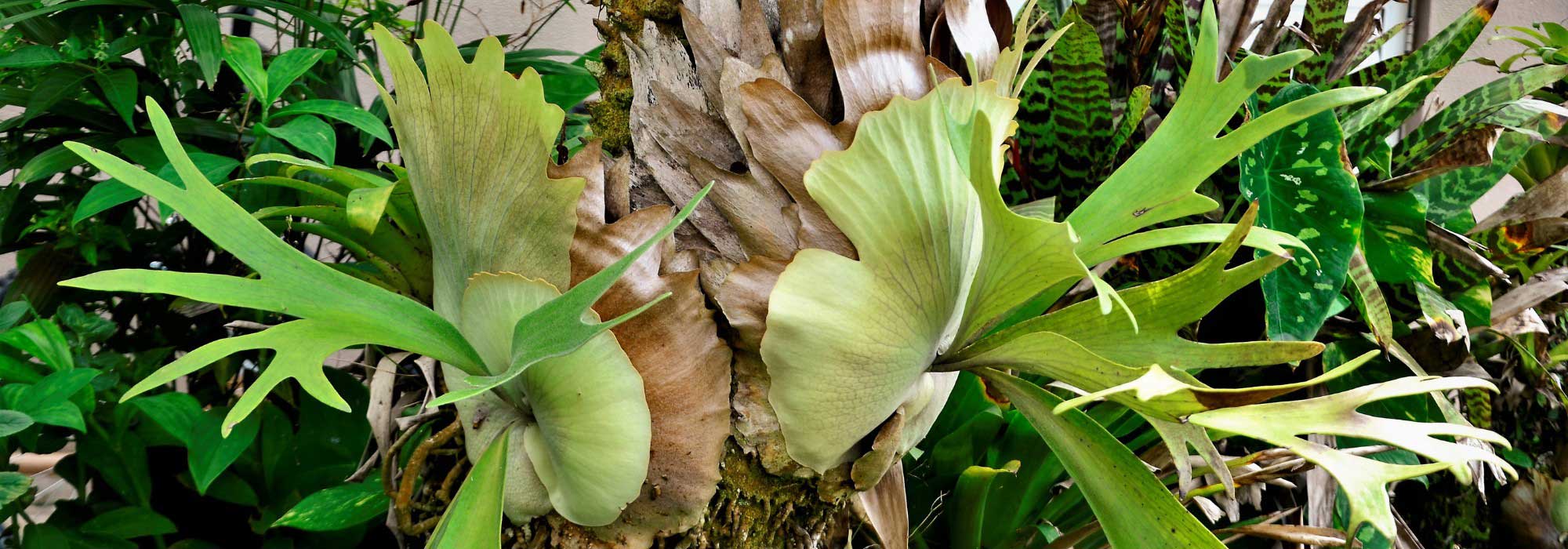
Platycerium, Staghorn Fern : cultivation and care
Contents
The Platycerium in a few words
- The Platycerium is a stunning tropical and epiphytic fern, which naturally grows attached to trees.
- It features highly divided fertile fronds, reminiscent of stag’s wood.
- Perfect for bright interiors, in hanging baskets or on wall mounts, it adds an original and graphic botanical touch.
- It requires filtered light, sufficient ambient humidity, and controlled watering.
The word from our expert
The Platycerium, is an epiphytic fern native to the humid tropical forests of Africa, Asia, Australia, and South America. Highly unique, it forms long trailing fronds resembling stag’s antlers. Its atypical silhouette inevitably catches the eye and sparks curiosity. The Platycerium is a plant that naturally grows attached to trees, without being parasitic. It feeds on the plant debris accumulated around its sterile fronds, making it an excellent example of plant adaptation.
Increasingly popular as a houseplant for its exotic appearance and moderate needs, the Platycerium appeals to both botany enthusiasts and lovers of plant decoration. Thanks to its specific yet simple requirements, it fits well indoors, in greenhouses, or conservatories, adding a touch of the jungle to any space.
Discover all our tips for successfully growing Platycerium, the most common species, best planting and care practices, as well as tricks for propagating and harmoniously pairing it with other houseplants.
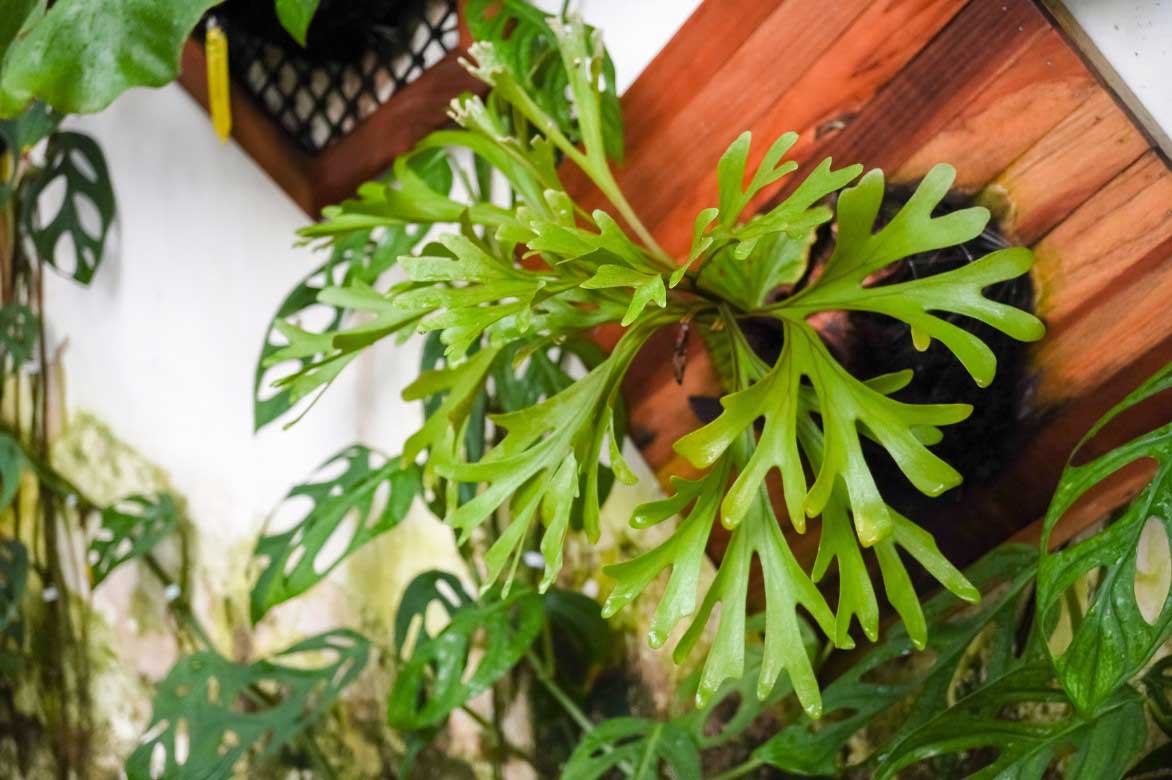
Description and Botany
Botanical data
- Latin name Platycerium sp.
- Family Polypodiaceae
- Common name Staghorn fern, Elk horn fern
- Flowering None
- Height Up to 1 m
- Exposure Bright, indirect light
- Soil type Well-draining and airy
- Hardiness Not frost-hardy
The Platycerium is an epiphytic fern native to tropical and subtropical regions across several continents: Africa, Southeast Asia, Australia, South America, and even some Pacific islands. It grows mainly in humid forests, where it clings to tree trunks and branches. Unlike parasitic plants, it does not harm its hosts, merely using them as support.
The Platycerium belongs to the Polypodiaceae family. This family includes around 1,000 species of ferns, primarily epiphytic and tropical. It is also the family of the Polypodium, a small fern with a creeping rootstock, which grows naturally in France, in woodland areas.
The Platycerium has a very distinctive habit, formed by two types of fronds. The sterile fronds, often rounded, are cup- or shield-shaped, and flatten against their support. They help anchor the plant and accumulate moisture and organic matter. They naturally turn brown over time, a normal process that should not cause concern: they remain important for the plant’s health.
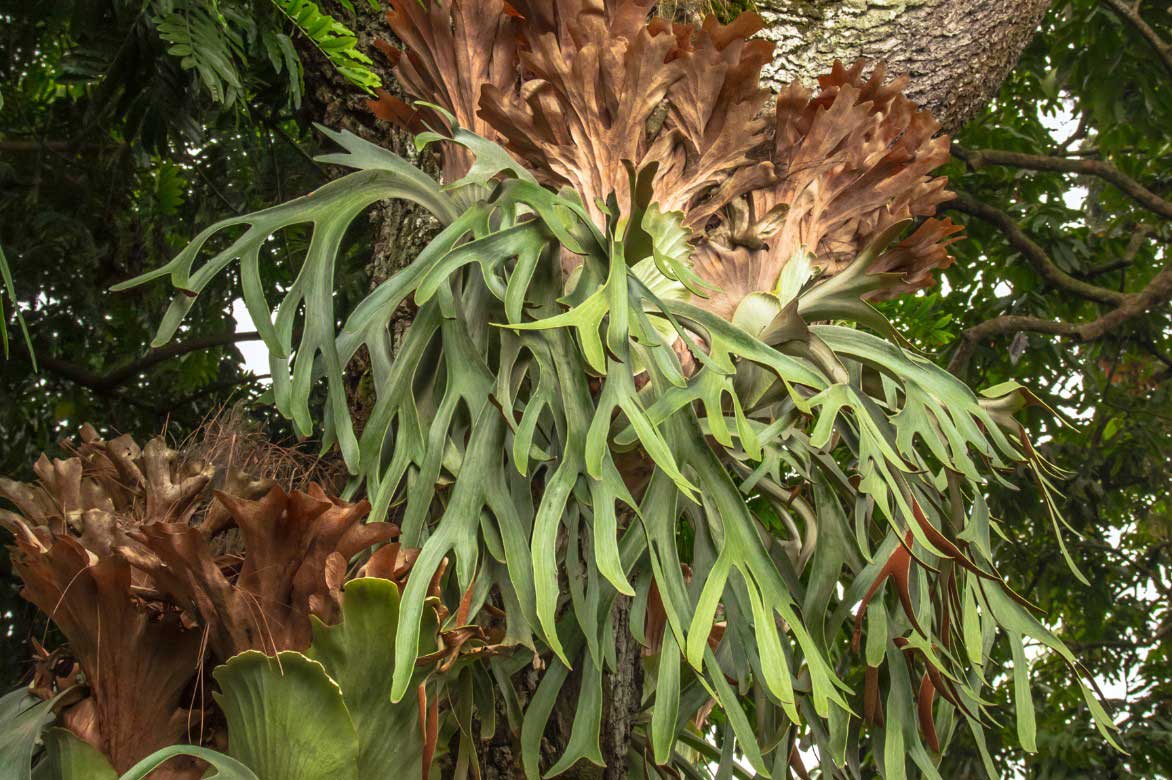
In its natural habitat, the Platycerium can reach impressive dimensions.
The Platycerium is particularly decorative thanks to its fertile fronds, long, arched or pendulous, deeply divided, resembling stag antlers. They are covered in a light silvery down, which helps the plant reduce water loss. These fertile fronds produce the spores necessary for reproduction. They give the Platycerium its common names of “Staghorn fern” or “Elk horn fern”. The combination of these two types of fronds creates a spectacular and highly graphic silhouette.
The size of the Platycerium varies depending on the species and growing conditions. Some species can reach up to 1 metre in all directions, or even more, when well-established. In pots or on a wall-mounted support, the plant gradually develops an imposing mass of trailing fronds, creating a cascading effect.
The genus Platycerium includes around twenty species. Each species is distinguished by the shape of its fronds, its size, its growth habit, and its cultivation requirements. Here are some of the most well-known and cultivated species:
- Platycerium bifurcatum: this is the most commonly cultivated species, particularly because it is the easiest to care for. Native to Australia and New Guinea, this Platycerium is prized for its green, arched fertile fronds, which can reach 90 cm in length. The sterile fronds are shield-shaped, initially green, then turn brown over time.
- Platycerium superbum: this species, also native to Australia, is spectacular. It forms a large rosette with very wide sterile fronds, which can curl outward to form a “bowl” designed to catch debris. The fertile fronds, often shorter than those of the bifurcatum, are also highly ornamental.
- Platycerium grande: native to the Philippines, this species resembles P. superbum, but its fertile fronds can reach impressive lengths, sometimes up to 2 metres. It is more challenging to cultivate and requires constant humidity.
- Platycerium alcicorne: this African species is quite similar to the P. bifurcatum, but its fronds are finer, more elegant, and often slightly twisted. It tolerates indoor cultivation well, provided it receives good humidity.
- Platycerium veitchii: native to Queensland, Australia, this species is recognisable by its silvery fronds covered in a very dense down. It prefers a dry atmosphere and tolerates slightly more direct light than other species.
There are also horticultural hybrids, such as the Platycerium ‘Netherlands’ or ‘Dutch Hybrid’. These combine the hardiness of the Platycerium bifurcatum with certain aesthetic characteristics of other species, such as wider fronds or faster growth.
The Platycerium is a non-hardy plant: it cannot tolerate frost and will die if temperatures drop below 10°C. It must therefore be grown indoors or in a temperate greenhouse in regions with cold winters.
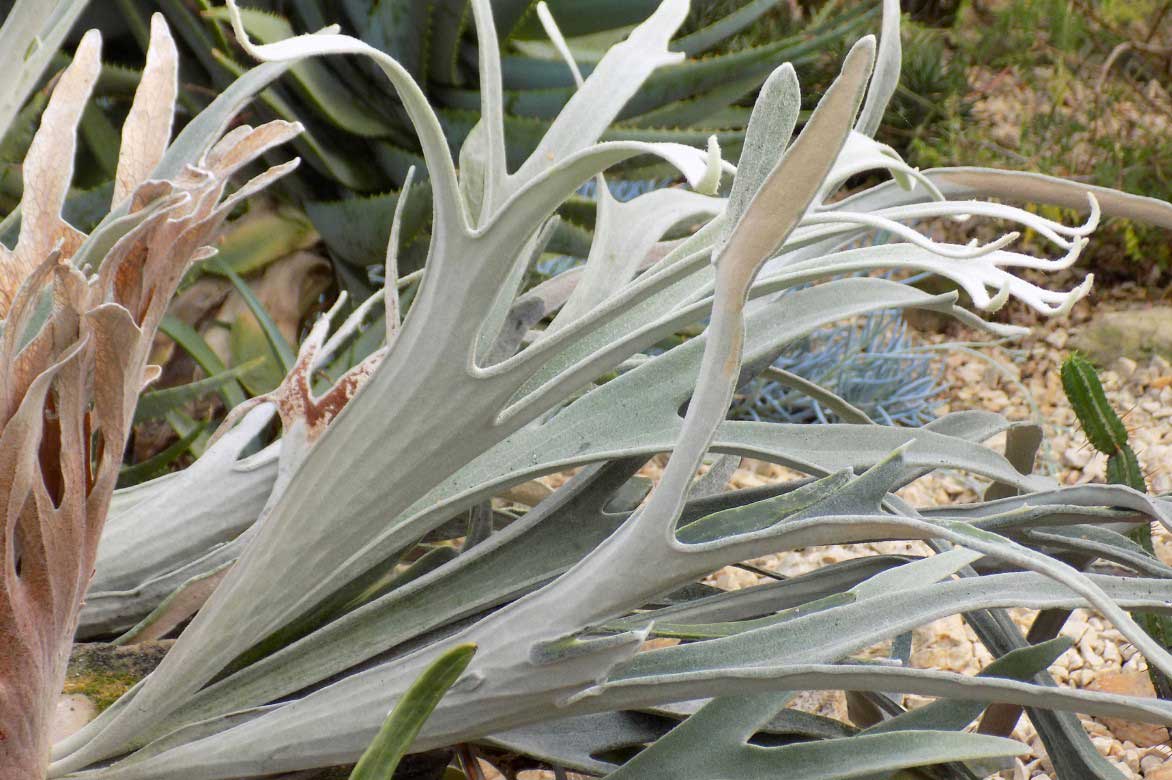
The Platycerium veitchii ‘Lemoinei’ stands out for its silvery-grey foliage.
The main species and varieties
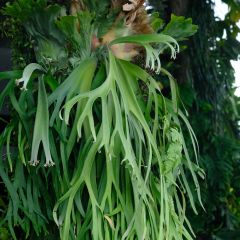
Platycerium bifurcatum - Staghorn fern
- Hauteur à maturité 70 cm
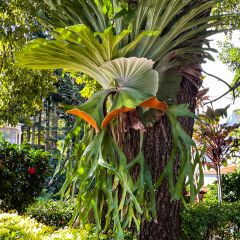
Platycerium alcicorne - Staghorn fern
- Hauteur à maturité 50 cm
Planting the Platycerium
Where to Install the Platycerium?
The Platycerium can be grown in a pot when young, but over time, the sterile fronds may completely cover the pot, treating it as a support since it is an epiphytic plant. It is better to install it directly (or not wait too long to install it) on a hanging support, for example, on a vertical board placed against a wall, on a decorative trunk or a driftwood branch, or in a hanging basket.
Regarding the location to choose, the Platycerium needs bright but filtered light. It thrives near a window facing east or west, with thin curtains to filter direct sunlight. Too much light will scorch its fronds, while insufficient light will slow its growth. As a tropical plant, it appreciates ambient humidity. A bright bathroom, conservatory, or greenhouse are ideal spots. In dry indoor conditions, mist its fronds regularly or use a humidifier. The ideal temperature ranges between 18 and 25 °C. It does not tolerate cold drafts or temperatures below 10 °C.
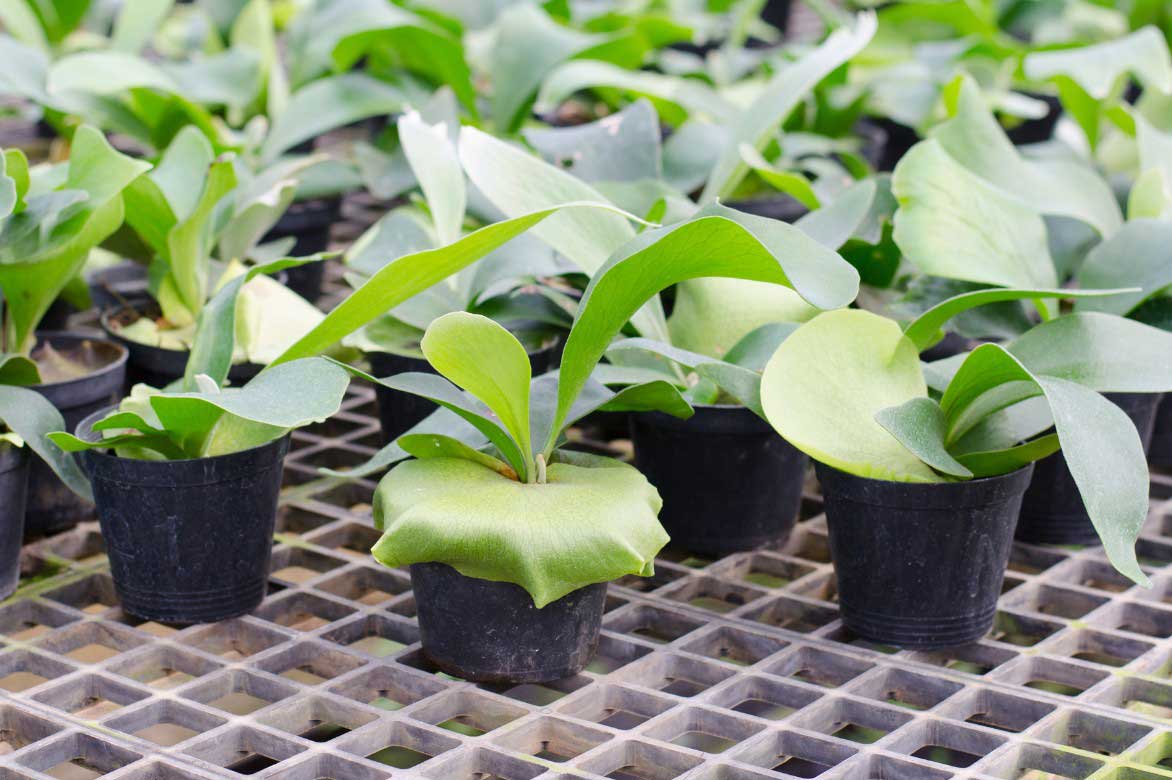
Young Platycerium plants grown in pots. The sterile fronds are already starting to cover the pots.
When to Plant It?
The best time to install a Platycerium is in spring or early summer, when the plant enters its active growth phase. This gives it time to adapt well to its new support or pot before winter.
How to Plant It?
It is possible to plant the Platycerium in a pot when young, but we recommend installing it directly on a vertical support.
In a Pot
- Use a wide, shallow pot with drainage holes.
- Prepare a light mix: pine bark, sphagnum moss, coconut fibres, and a bit of perlite.
- Place the plant on the mix without burying it: only the roots should touch the substrate.
- Water sparingly and allow it to dry well between waterings.
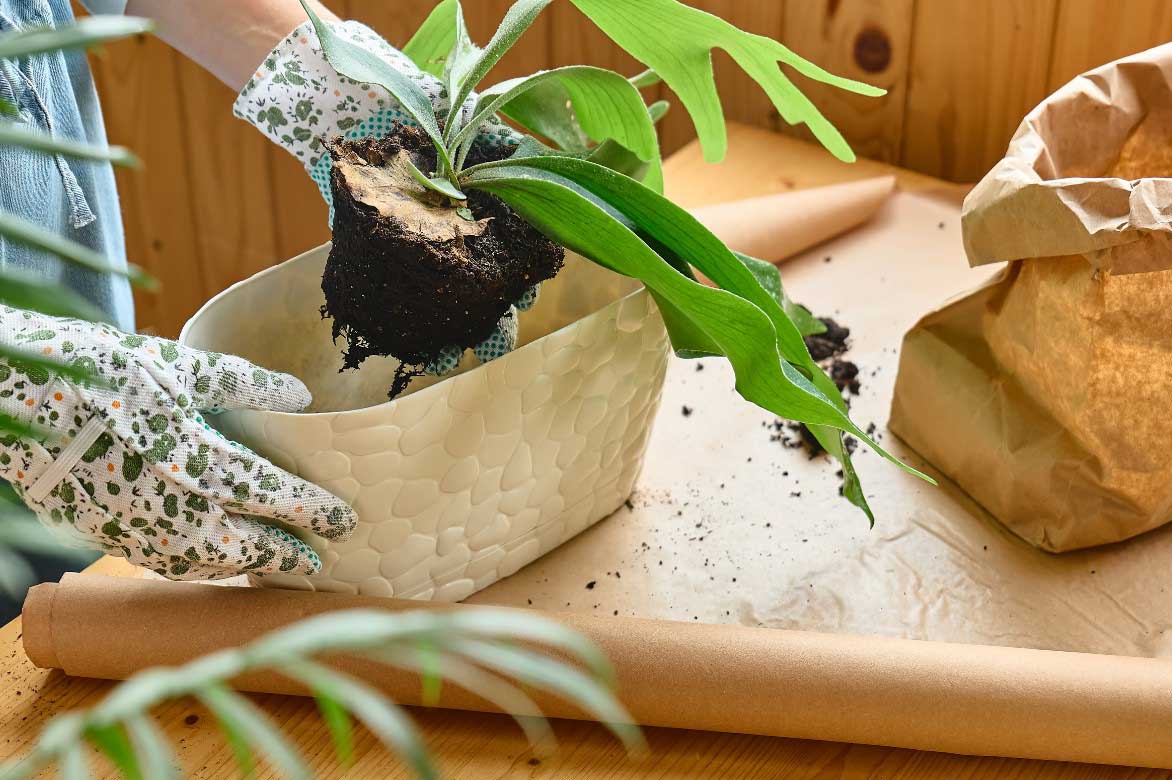
Planting in a pot is suitable for the youngest plants.
On a Wall Support (Board or Wooden Plaque)
- Use untreated wood or a cork support.
- Place a handful of moistened moss or sphagnum in the centre.
- Install the Platycerium on the moss, positioning the sterile fronds downward so they can spread.
- Secure everything with wire, without tightening too much.
- Water generously after installation.
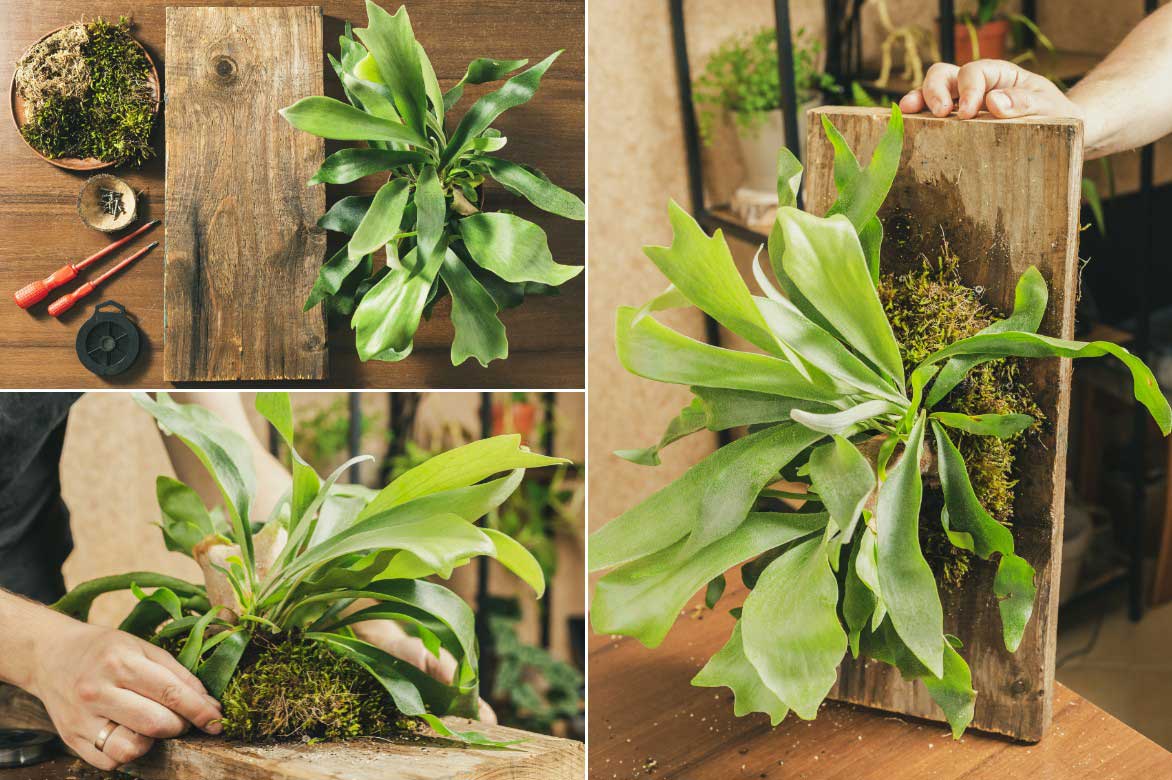
The Platycerium is very decorative when installed on a vertical support like a wooden board. The moss helps secure it and maintain moisture around its roots.
How to care for the Platycerium?
Exposure
The Platycerium enjoys good light but dislikes direct, scorching sunlight. Ideally, place it near an east or west-facing window. A south-facing exposure is also possible, provided you filter the direct sunlight with a sheer curtain. Conversely, a room that is too dark will hinder its growth, resulting in pale and weak fronds.
Watering
Watering, on the other hand, must be carefully measured. Too much water can cause root rot or sterile fronds, while prolonged dehydration will dry out the plant. If you grow it on a wall-mounted support, soak the entire support in a basin of water for 15 to 30 minutes, once a week in summer, and every 10 to 15 days in winter. Allow the support to drain thoroughly before putting it back in place.
If you grow it in a pot, simply water when the substrate feels dry to the touch, ensuring that water never stagnates at the bottom of the pot. Visual monitoring is helpful: fronds that become soft or wrinkled often indicate a lack of water, while browning at the base of the fronds may signal overwatering.
Ambient Humidity
Native to tropical forests, the Platycerium thrives in a humid atmosphere. It flourishes in environments where relative humidity exceeds 50%, which can be achieved naturally in a bathroom or artificially with a humidifier. During dry periods or in heated interiors, it is advisable to mist the fronds regularly (2 to 3 times a week), while avoiding soaking the sterile fronds, especially in winter.
Cleaning and Pruning
Regarding foliage maintenance, it is recommended not to prune or remove the sterile fronds, even when they turn brown. These play a crucial role in protecting the plant and retaining moisture. However, you can gently remove dead or detached fronds. Dusting can be done with a dry, soft brush to avoid damaging the velvety surface of the fertile fronds.
Fertiliser
Fertiliser is not essential, but it can promote more vigorous growth, particularly during the active period in spring and summer. You can apply (no more than once a month) a weakly diluted liquid fertiliser, suitable for epiphytic plants or orchids. Avoid nitrogen-rich fertilisers, as they may damage the fronds.
Diseases and Pests of the Platycerium
The most common issue with the Platycerium is the rotting of the fronds or the heart of the plant. This usually occurs due to excess moisture or poor drainage. If the sterile fronds turn brown quickly, become soft, or emit an unpleasant odour, it may indicate that the plant is overwatered or not drying properly after soaking. It is then advisable to reduce watering, allow the plant to dry for longer, and improve ventilation around the support or pot.
Parasites are not very common, but you may occasionally notice mealybugs, particularly on the sterile fronds or along the veins of the fertile fronds. These small white or brown insects feed on the sap and gradually weaken the plant. It is important to remove them manually as soon as they appear, using a cotton pad soaked in 70% alcohol or with a natural treatment based on diluted black soap. A severe infestation may require isolating the plant and multiple treatment applications.
Aphids and spider mites can also appear if the air is too dry, especially in heated indoor environments. Aphids cause curling or weakening of the fronds, while spider mites leave small yellow spots and very fine webs. Increasing ambient humidity, regular misting, and cleaning the fronds are good preventive measures to avoid these attacks. If in doubt, a lukewarm shower under a gentle spray can often dislodge these small invaders.
Finally, slowed growth, pale or deformed fronds may indicate a lack of light or a nutrient deficiency. In this case, a moderate application of suitable fertiliser and repositioning the plant in a brighter location may be enough to improve its health.
Vigilance, regular observation, and good cultivation hygiene are the best allies for keeping a Platycerium in top condition.
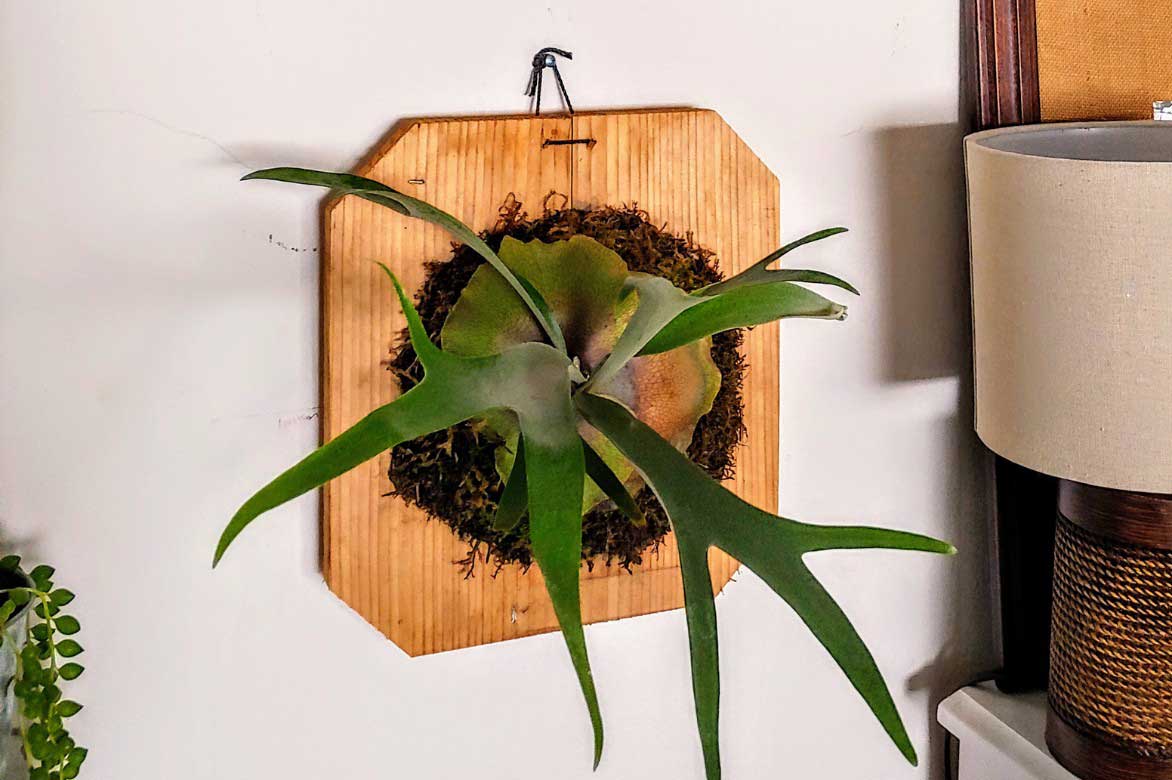
How to propagate the Platycerium?
Propagating a Platycerium is an excellent way to extend the enjoyment of its cultivation, share this plant with other enthusiasts, or simply expand your collection. There are mainly two methods: removing offsets and sowing spores.
Propagating Platycerium by Removing Offsets
This is the simplest and quickest method.
When to Remove Platycerium Offsets?
The ideal time is in spring, during the active growth period, preferably when repotting or changing the support.
How to Do It?
- Identify a well-formed secondary rosette, with its own fronds and roots.
- Gently detach it from the mother plant using a clean, sharp knife if necessary.
- Attach this new plant to a support (wooden board, cork) or place it in a pot with a light, well-draining mix.
- Water lightly and maintain good ambient humidity to encourage rooting.
How to Sow Platycerium Spores?
More technical and time-consuming, this method is reserved for experienced gardeners or those curious about the complete life cycle of ferns. It allows you to obtain many plants from just one.
When to Sow the Spores?
You can sow them year-round, provided you have a warm and humid environment.
How to Do It?
- Harvest mature spores found on the underside of fertile fronds, appearing as brown dust.
- Sow them on the surface of a sterile, moist substrate (finely chopped sphagnum moss, fine peat).
- Cover with a cloche or transparent lid to maintain constant humidity.
- Place in a warm, bright spot, away from direct sunlight.
- Wait for germination (several weeks to several months), followed by the development of prothalli and then young plants.
- Transplant when the young ferns are large enough to handle.
For more advice, feel free to consult our dedicated guide: “How to Sow Fern Spores?”
How to showcase the Platycerium and which plants to pair it with?
The Platycerium pairs beautifully with other tropical plants that share its need for filtered light and high ambient humidity. You can combine it with orchids, bromeliads, or anthuriums, which, like it, thrive in warm and humid environments. The calatheas, philodendrons, and monstera create an interesting contrast with their large, solid or variegated leaves. Their soft shapes and lush foliage form a beautiful balance with the delicate, airy fronds of the Platycerium.
Thanks to its trailing habit and ability to thrive on vertical supports, the Platycerium is perfect for creating a living wall, alternating with classic ferns, pothos, or creeping plants. It can also be used to compose a plant frame, where it takes center stage, surrounded by more discreet yet complementary plants.
To highlight its “wild” and epiphytic nature, opt for natural materials: hang it, for example, on a raw wood plank, a piece of driftwood, or a cork bark. Place it near stones, pebbles, or on a driftwood shelf for a zen and natural ambiance.
Suspended in a basket or mounted on a wall plank, the Platycerium becomes a decorative piece in its own right. It can serve as the focal point of a plant mobile, surrounded by small trailing plants like dischidia or hoyas. It can also occupy a wall niche with indirect lighting for a sculptural effect, day or night.

The Platycerium easily creates a very exotic effect on a wall, as seen here paired with Monsteras
Also worth reading
- Discover our full range of houseplants, as well as our range of indoor ferns
- Our books on houseplants
- Subscribe!
- Contents
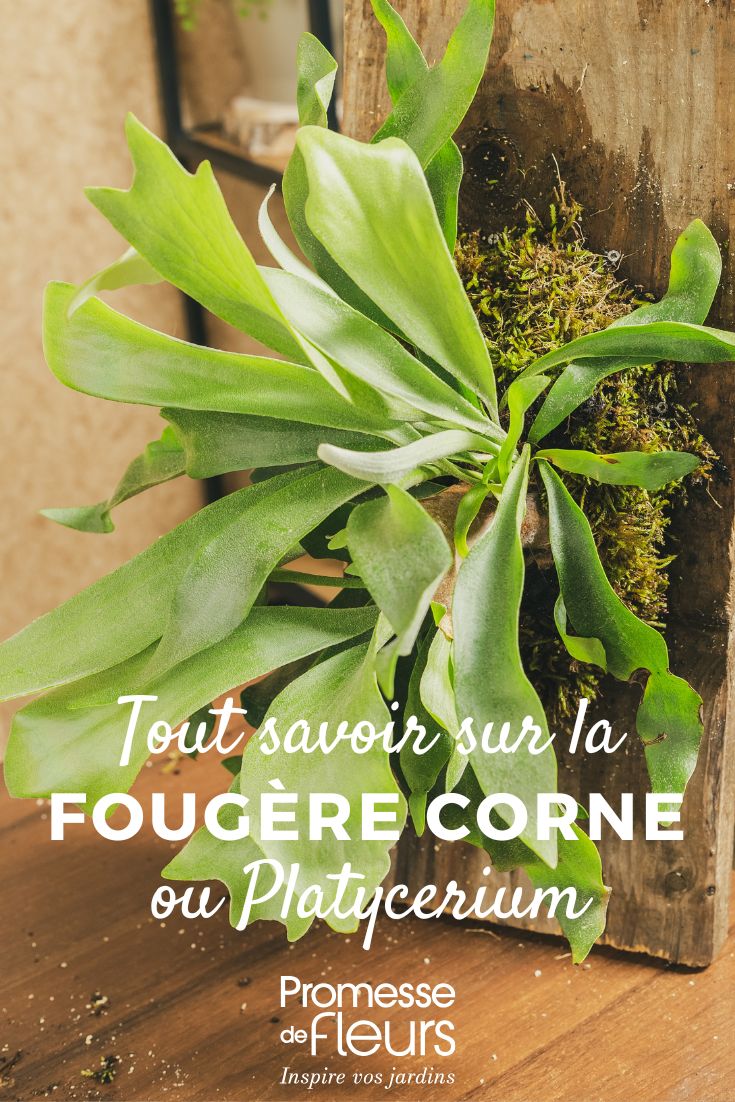































Comments